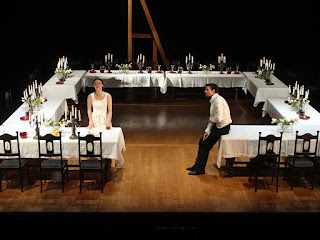Theater Review: A Low-Voltage Russian revival of Schiller’s Love and Intrigue
Love and Intrigue
(Kabale und Liebe)
Written by Friedrich Schiller
Directed and adapted by Lev Dodin
Maly Drama Theatre of St. Petersburg, Russia
Brooklyn Academy of Music
June 16, 2018
As I was watching this rare US performance of a play by the
famed German classicist playwright Johann Christoph Friedrich von Schiller
(1759-1805), I kept thinking that I was at an early Verdi opera, just with no
music. Perhaps it was the supratitles (the actors were speaking Russian, in an
adaptation for the St. Petersburg troupe performing it) or the melodramatic events—lots
of court plotting and frustrated love. Then it occurred to me…the Luise in the
lead role was in fact also the Luisa of the title role in Verdi’s early opera Luisa Miller (1849). It turns out that
Schiller’s plays, rarely performed on stage these days (at least outside
Germany), were a favorite of romantic opera composers. His plays were the basis
for Rossini’s William Tell (1829), Donizetti’s
Maria Stuarda (1835), then Verdi’s I Masnadieri (1847), Luisa Miller (1849), and Don Carlos (1867). The plots are rich
with coincidence, (melo)dramatic surprise turns, and tortured (metaphorically
and actually) characters. We should remember that Schiller was writing these
plays in the late 18th century, a time when French, English and
certainly American playwrighting was not very good. His plays were therefore
wildly popular and influential in Europe, along with those of his contemporary
Goethe.
So how does Love and
Intrigue (1784) do now as a straight play, without the emotionally amplification
of opera singing and orchestration? The plot revolves around the love by young
Ferdinand, the son of the president of the Duchy, for Luise Miller, daughter of
a humble music teacher. Luise is also loved by the aristocrat Wurm, setting in
motion lots of plotting by Ferdinand’s father to get Luise married off to Wurm,
while pairing Ferdinand to the older, morally fallen English aristocrat Lady
Milford. The action is a mix of drama and comedy, and the director used a light
touch in not overplaying the melodrama. The interest in the plot lies in the
blunt portrayals of class conflicts and stupidity of the ruling class, doubtless
risky in the aristocracies of the late 18th century. In that it
reminded me of The Marriage of Figaro,
written about the same time by Beaumarchais in France. Schiller was a pioneer of
the German Sturm und Drang (Storm and
Stress) movement that favored emotion and subjectivity over tight logical
control, so it is no wonder that later opera composers gravitated to his
melodramatic plots.
That said, this is not quite Shakespeare or O’Neill. Chekhov,
Ibsen, and Strindberg are still a century away. There is little in the plot to
compel reflection or real dramatic tension for a modern audience, and character
development is rudimentary. This Russian
production did its best to keep things moving, with quick set changes, excellent
acting, well-done supratitle translations, and inventive lighting and sound
design. The director chose music matched to era, mostly choosing Beethoven as the
musical backdrop. Costumes were appropriate for the era, with aristocrats in
tuxedos and gowns. The basic set of interchangeable tables and chairs without
much backdrop was cleverly manipulated by six hunky young guys in white
tuxedos, constantly moving things about and frowning at inappropriate
activities they saw on stage, like meddlesome servants. The young Ferdinand,
whose love for a woman lower than his class provides most of the dramatic fuel,
was charmingly played by Danila Kozlovsky. His initial entrance, and the very
opening of the play, was basically a flying leap acrobatically landing prone on
top of a table to kiss his love Luise.
This made pretty clear both his
intentions and what the play would focus on. The versatile Ksenya Rappaport
played Lady Milford, an aging, morally fallen British aristocrat forced into
being a concubine for the Duke and a potential wife for Ferdinand. Ms. Rappaport
was wonderful, mixing acrobatic dance-like entrances and exits with acting of a
wide dynamic range. She was a conflicted character, not truly comfortable in either
the upper or lower class.
Schiller’s writing for her comes the closest to
achieving a truly three-dimensional character. Her dancelike performance contrasted
with the director’s general approach of having people march on and off stage
with sharp right angle turns, perhaps to show their entrapment in class roles.
This got a bit old after a while. While I enjoyed the performance, it seemed
long, and this is not a play that I would care to see again. I think the
operatic adaptations of Schiller best in the modern world.



Comments
Post a Comment